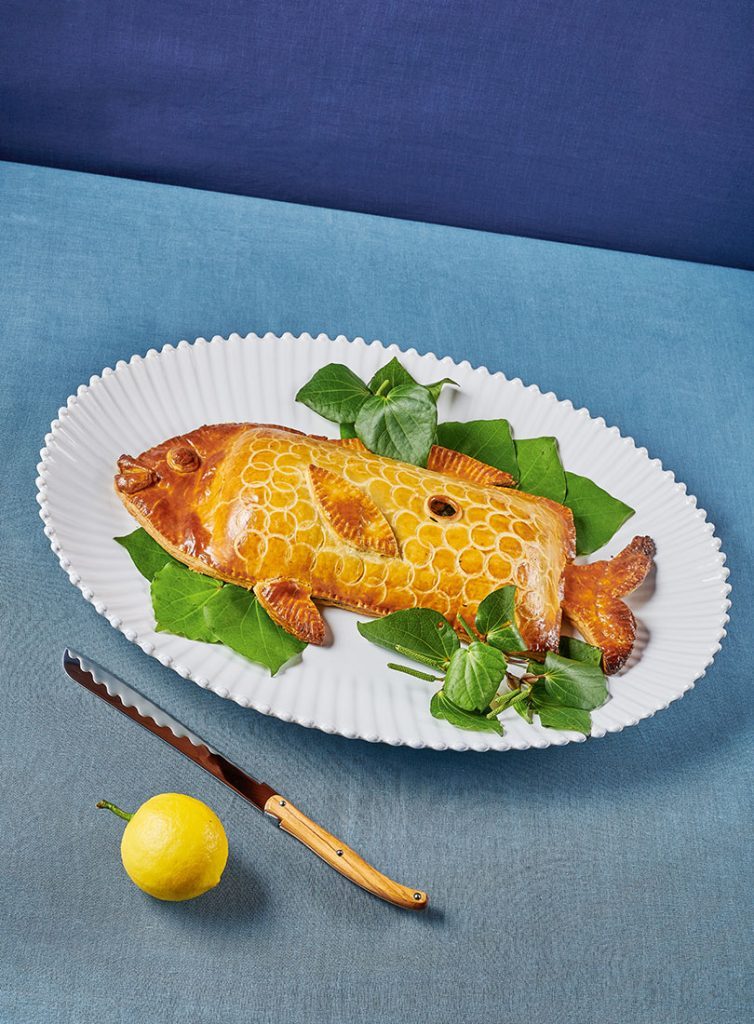Salmon Coulibiac With Sole & Kawakawa Mousse
Martin Bosley

Serves
10Preparation
1½ hrs plus restingCook
40 minsIngredients
| FOR THE PASTRY | |
| 500g plain flour | |
| 10g salt | |
| 250g unsalted butter, diced | |
| 3 free-range egg yolks | |
| 30ml milk | |
| 80ml iced water | |
| SOLE & KAWAKAWA MOUSSE | |
| 400g white fish, skinned and boned fillets (I used sole fillets, but a soft-fleshed white fish such as snapper, tarakihi or moki will do. Or go completely mad and use scallops with the roe removed.) | |
| 1 free-range egg | |
| 250ml cream | |
| 2 teaspoons dried kawakawa | |
| TO ASSEMBLE | |
| 1kg side of salmon, skinless and pin-boned | |
| 6 nori seaweed sheets | |
| 1 egg, beaten with a pinch of salt | |
| SOUR CREAM SAUCE | |
| 1 cup sour cream | |
| 2 tablespoons water | |
| juice of 1 lemon |
I use Akaroa salmon. The Bates family has been farming salmon in the cold, clear waters of Akaroa Harbour in Canterbury for 35 years, and the salmon has a distinctly clean, non-oily flavour. Serve with a salad of watercress.
FOR THE PASTRY
I want to thank Phillip Blackburne from Embra restaurant in Taupo for his wisdom and advice. The pastry recipe is his. If this seems like a lot of salt, it is. It all makes sense though when eaten with the salmon.
View the recipe collection here
Instructions
| 1. | PASTRY |
| 2. | Place the flour and salt in a mixing bowl. |
| 3. | Rub the butter through the flour to a fine crumb – you can do this by hand or use an electric mixer. |
| 4. | Mix the egg yolks with the milk and water. |
| 5. | Add to the flour and work to a smooth dough. |
| 6. | Wrap in plastic wrap and refrigerate for at least 30 minutes. |
| 7. | SOLE & KAWAKAWA MOUSSE |
| 8. | Combine the fish and egg in a food processor and blitz until smooth. Season with salt and white pepper. |
| 9. | With the motor running, pour in the cream through the feed tube and process for about 10 seconds – don’t leave it for too long or the mousse will come out rubbery. |
| 10. | Scrape the mixture into a large sieve set over a bowl and, using the back of a kitchen spoon, ladle or a pastry scraper, force the mixture through the sieve. |
| 11. | Add the kawakawa and check the seasoning by cooking a teaspoon of mixture in a microwave for 1-2 minutes. |
| 12. | Cover and chill the mixture until it’s time to assemble the coulibiac. |
| 13. | TO ASSEMBLE |
| 14. | Heat the oven to 200 ̊C. |
| 15. | Divide the pastry in half and roll out one half on a floured board to a rectangle wider and longer than the side of salmon. |
| 16. | Place a piece of baking paper on a flat baking sheet and transfer the pastry to the tray. |
| 17. | Place three sheets of nori on the pastry leaving a border of pastry around the edges. |
| 18. | Lay the salmon, skinned-side down on top of the nori and season with sea salt only. |
| 19. | Use a palette knife to spread the fish mousse over the top and around the sides of the salmon to about a 2cm thickness. |
| 20. | Lay the remaining sheets of nori over the mousse and use your hands to smooth everything down. |
| 21. | Wet the edges of the nori and press together to form a sealed package. |
| 22. | Roll out the reserved pastry to a rectangle larger than the first in order to cover the salmon. |
| 23. | Brush the edges of the pastry base with beaten egg and gently drape the pastry over the top, smoothing the pastry over the fish to exclude as much air as possible. |
| 24. | Press the edges together then crimp with the tip of a fork – it’s up to you if you want to make a fish shape. |
| 25. | Trim the edges to neaten. Pierce the top to allow steam to escape and place a small ring of pastry around the hole. |
| 26. | Brush the pastry with beaten egg and leave for 10 minutes, then brush again. |
| 27. | Use a small pastry cutter to create the effect of scales, pressing gently into the pastry but not cutting right through. |
| 28. | The uncooked pie can now be refrigerated, on the baking sheet, for a day. |
| 29. | Bake for 20 minutes then lower the heat to 180 ̊C and bake for a further 20 minutes. |
| 30. | Remove the coulibiac from the oven and leave to cool for about 10 minutes before slicing and serving with the sauce. |
| 31. | SOUR CREAM SAUCE |
| 32. | Combine everything in a bowl and whisk together until smooth, then season with a pinch of salt. |
Food and recipe styling Martin Bosley / Photography Amber-Jayne Bain
